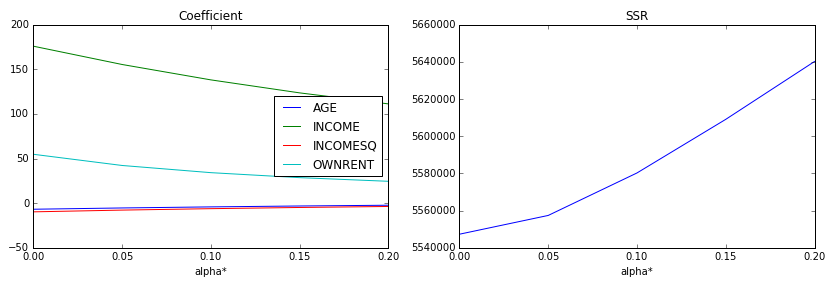As I know, there is no R(or Statsmodels)-like summary table in sklearn. (Please check this answer)
Instead, if you need it, there is statsmodels.regression.linear_model.OLS.fit_regularized class. (L1_wt=0 for ridge regression.)
For now, it seems that model.fit_regularized(~).summary() returns None despite of docstring below. But the object has params, summary() can be used somehow.
Returns: A RegressionResults object, of the same type returned by fit.
Example.
Sample data is not for ridge regression, but I will try anyway.
In.
import numpy as np
import pandas as pd
import statsmodels
import statsmodels.api as sm
import matplotlib.pyplot as plt
statsmodels.__version__
Out.
'0.8.0rc1'
In.
data = sm.datasets.ccard.load()
print "endog: " + data.endog_name
print "exog: " + ', '.join(data.exog_name)
data.exog[:5, :]
Out.
endog: AVGEXP
exog: AGE, INCOME, INCOMESQ, OWNRENT
Out[2]:
array([[ 38. , 4.52 , 20.4304, 1. ],
[ 33. , 2.42 , 5.8564, 0. ],
[ 34. , 4.5 , 20.25 , 1. ],
[ 31. , 2.54 , 6.4516, 0. ],
[ 32. , 9.79 , 95.8441, 1. ]])
In.
y, X = data.endog, data.exog
model = sm.OLS(y, X)
results_fu = model.fit()
print results_fu.summary()
Out.
OLS Regression Results
==============================================================================
Dep. Variable: y R-squared: 0.543
Model: OLS Adj. R-squared: 0.516
Method: Least Squares F-statistic: 20.22
Date: Wed, 19 Oct 2016 Prob (F-statistic): 5.24e-11
Time: 17:22:48 Log-Likelihood: -507.24
No. Observations: 72 AIC: 1022.
Df Residuals: 68 BIC: 1032.
Df Model: 4
Covariance Type: nonrobust
==============================================================================
coef std err t P>|t| [0.025 0.975]
------------------------------------------------------------------------------
x1 -6.8112 4.551 -1.497 0.139 -15.892 2.270
x2 175.8245 63.743 2.758 0.007 48.628 303.021
x3 -9.7235 6.030 -1.613 0.111 -21.756 2.309
x4 54.7496 80.044 0.684 0.496 -104.977 214.476
==============================================================================
Omnibus: 76.325 Durbin-Watson: 1.692
Prob(Omnibus): 0.000 Jarque-Bera (JB): 649.447
Skew: 3.194 Prob(JB): 9.42e-142
Kurtosis: 16.255 Cond. No. 87.5
==============================================================================
Warnings:
[1] Standard Errors assume that the covariance matrix of the errors is correctly specified.
In.
frames = []
for n in np.arange(0, 0.25, 0.05).tolist():
results_fr = model.fit_regularized(L1_wt=0, alpha=n, start_params=results_fu.params)
results_fr_fit = sm.regression.linear_model.OLSResults(model,
results_fr.params,
model.normalized_cov_params)
frames.append(np.append(results_fr.params, results_fr_fit.ssr))
df = pd.DataFrame(frames, columns=data.exog_name + ['ssr*'])
df.index=np.arange(0, 0.25, 0.05).tolist()
df.index.name = 'alpha*'
df.T
Out.
![enter image description here]()
In.
%matplotlib inline
fig, ax = plt.subplots(1, 2, figsize=(14, 4))
ax[0] = df.iloc[:, :-1].plot(ax=ax[0])
ax[0].set_title('Coefficient')
ax[1] = df.iloc[:, -1].plot(ax=ax[1])
ax[1].set_title('SSR')
Out.
![enter image description here]()
In.
results_fr = model.fit_regularized(L1_wt=0, alpha=0.04, start_params=results_fu.params)
final = sm.regression.linear_model.OLSResults(model,
results_fr.params,
model.normalized_cov_params)
print final.summary()
Out.
OLS Regression Results
==============================================================================
Dep. Variable: y R-squared: 0.543
Model: OLS Adj. R-squared: 0.516
Method: Least Squares F-statistic: 20.17
Date: Wed, 19 Oct 2016 Prob (F-statistic): 5.46e-11
Time: 17:22:49 Log-Likelihood: -507.28
No. Observations: 72 AIC: 1023.
Df Residuals: 68 BIC: 1032.
Df Model: 4
Covariance Type: nonrobust
==============================================================================
coef std err t P>|t| [0.025 0.975]
------------------------------------------------------------------------------
x1 -5.6375 4.554 -1.238 0.220 -14.724 3.449
x2 159.1412 63.781 2.495 0.015 31.867 286.415
x3 -8.1360 6.034 -1.348 0.182 -20.176 3.904
x4 44.2597 80.093 0.553 0.582 -115.564 204.083
==============================================================================
Omnibus: 76.819 Durbin-Watson: 1.694
Prob(Omnibus): 0.000 Jarque-Bera (JB): 658.948
Skew: 3.220 Prob(JB): 8.15e-144
Kurtosis: 16.348 Cond. No. 87.5
==============================================================================
Warnings:
[1] Standard Errors assume that the covariance matrix of the errors is correctly specified.


